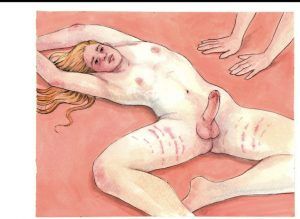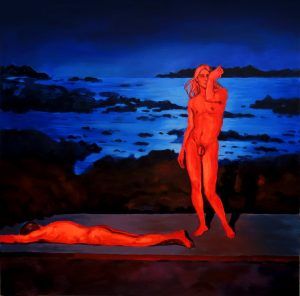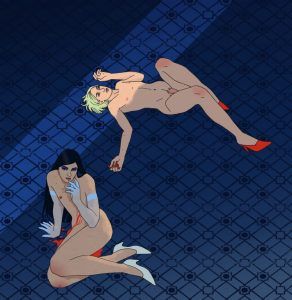I want your horror, I want your design.
Lady Gaga
“I’ve never been conscious of my relationship with colors, as a child I liked green, then blue… I know I don’t like purple. I don’t think about it. When I mentally visualize an image, purple is not there, I don’t see it. There is pink, red, beige, yellow, but there is no purple.” While the Cuban visual artist, son of scientific parents —the mother is a microbiologist and the father is a biochemist—, is saying it, he searches for each one of the tones, frantically looks for them in the room with that surprised look so peculiar to him that stops on the sofa, on the edges of his own paintings, on his black cat that comes and goes, caressing with her tail the ears of corn on the coffee table. He goes about saying it with a responsibility he is perhaps unaware of, that of being one of the most interesting and bizarre Cuban painters of recent years.
On his Instagram page, which is a mirror ball of his paintings, white ripped thighs, pulled out fingernails, broken noses, belonging to the series Si te mueves, te corto (If You Move, I’ll Cut You) appear on the tiles. A group of threatening paintings that speak from a place that resembles violence, sex and love, which can also be a place that does not resemble any of that, that only feeds on all that, and that is a white heel, a red enamel, a phone that rings and rings and in the end nobody answers. An unclassifiable place, but extremely close to despair.

“I wanted to study something that didn’t stray from the creative, but that was practical, where no one would shove down my throat some mumbo jumbo. And so, I studied architecture. And I felt good, I said, this is my thing. Very different from how I felt in San Alejandro. Around this time, I came out of the closet, I felt better, I was openly gay. My parents were supportive, we’re close, they’ve always helped me with art and with animals, because I had a lot of animals as a kid, and they allowed it.”
On April 1, 2019, Nazabal posted a boy with green hair carrying an iguana on his shoulder, the boy is taking a selfie and is wearing a red coat, made redder by the deep green of the reptile. He reminds you of those boys you see in the street after midnight, with their heads half shaved and evil in their fangs, he reminds you of the cold bloods, the slashes. A drawing that is a sample of his need to paint personalities that are little expressed, little investigated. If Nazabal’s painting had a classification schedule, I would say it is the early morning.
Now he goes on talking about animals and how he painted them when he was a child, he stops, with an unusual seriousness to tell me he even drew the sexes of animals. Lions’ penises. Horses’ penises. And all very realistic.

“They weren’t stick people or little houses.” He laughs and talks again about his beginnings as an architect: “In that period I met my boyfriend, Enzzo, and I started to draw him, resuming again a desire I had lost in San Alessandro.” Enzzo, the boyfriend, enters the room to say something to Nazabal about some tuna fish being cooked, he enters as if coming out of one of the many paintings in which his face appears. In one painting Enzzo is on the grass, reading, and in another, he is wearing a little crown. Also, in the living room, which is full of books and easels and flowers, there are paintings of other fantastic boys…

Some are blond, with that lost look of well-paid models, others wear headscarves and dress in animal print, others exhibit pink, monumental penises, holding them, as if to say, oh, come on, look at this beauty. In Nazabal’s imaginary everything contains the sexual, sex attacks you from figurative actions: fingers in the mouth, legs on benches, bloody knees, pelvises raised like bridges. In his works sex happened before and there are explicit indications of the act, or it is suggested by the atmosphere that it is going to take place. Sex is in these paintings a devotion, a mark of instinct. They are passionate, pleasurably painful works, as if wrapped in towels, freshly bathed and offered.

“When I opened Instagram, I discovered a universe that I didn’t know existed of openly queer, openly gay people. There are images and accounts that I see and someone or something inspires me and I paint it. I don’t look for realism, you know? I love Gucci, Balenciaga, I’m inspired by those Gucci catwalks with severed heads and rubber dragons. I’ve been changing a lot, at the beginning I was only interested in characters and a flat background, then the environments…, now I’m very interested in atmospheres. I want something to stand out. The light. As in Fogata de verano. I had never painted canvases before, apart from San Alejandro, which I don’t count. There is an architectural studio where what matters is the concept, their projects do not come to fruition, and they have perfect white-black grids on landscapes, and then people or objects are placed on top of those landscapes. And some time ago I made a series of collages that I titled Locales hostiles, where I put images of myself over scenarios that I recreated, and with Fogata de verano I wanted to return to that. Them standing on a flat platform and rocks from the sea, which we don’t know why they are there but it doesn’t matter either. And I was having that use of red light on the bodies…”

I tell him that his titles tend to be caustic. He smiles.
“¿En serio, mijito? it’s something very much ours (he refers to him and his boyfriend). I talk about what happens to me and what interests me. And that was something that bothered me in San Alejandro, to feel that I had to look for something external. I didn’t have the courage to tell something of my own, but I don’t feel that pressure anymore. Generally, I see something that suggests an idea and I go and do it. Or I am constantly looking at references, this is something we architects do a lot, we look at images to arrive at an idea. I accumulate references that catch my attention, and then, when I feel like doing something, I go through that folder, as if looking for inspiration.”
And he is inspired by transparent fabrics, lace.
Lipsticks.
The delicate skins.
The beautiful jaws.
He is inspired by sensuality. Luxury brands. Pop stars.
Like in that drawing in which a young guy with blue gloves covers his nipples, like in that drawing in which a cell phone screen illuminates the fuchsia eyelids of a youngster with nineties bangs and orchid sleeves.
“It had a lot to do with my liberation. I’m openly queer, this is what I enjoy, I want to draw cute boys. I wouldn’t say I’m changing it, but I feel like I’m not doing the same as I used to, in regards to bodies and physicality. Another milestone moment of my realization, also because of Instagram, which is my working tool, was when I was contacted to be in The Queer Bible, an anthology by queer people about queer people, anthology where you can find Elton John and a bunch of other important people. And the editor asked me to illustrate a text about Félix González Torres written by Hans Ulrich Obrist, who is the director of one of the most important architectural projects in the world, the Serpentine Pavilion, where all the architects I admire have been. I wanted to die.”

Suddenly Han Ulrich Obrist was following him on Instagram!
“Of Felix there are very few photos, and I almost had to make him up from blurry Polaroids with his boyfriends on the beach, what there were photos of were his cats, which I used for obvious reasons.”
Nazabal loves cats, one could say he is fascinated by their elegance. And in many of his paintings the characters hold cats or caress them, as if seeking a sincere form of companionship and love. In Nazabal’s paintings, when a cat appears, the characters have a more serene expression, they feel, perhaps, less lonely.
The conversation inexplicably concludes on one of those bombastic balconies of the National Museum of Fine Arts, looking at the perfect buttocks and biceps of Greek art made before Christ. Nazabal is covered by the museum’s cerulean light and reveals things under the visor of his cap, things like drastic changes in his weight, an old bob cut, being a member of a Cuban society of cat lovers…
He talks about his past as if he’s not so young, and suddenly, just suddenly, he’s not.
Behind us there is an exhibition of Dutchman Jacobus Houbraken, boring, flat portraits, no second thoughts, no pinkish and blond tones of the Nazabal boys, portraits without bitten mouths or perfect cuts, no clutching penises and little red eyes.
When I turn to see him again, Nazabal is no longer on the balcony, and going out to the Central Park I only find that blue hour, strange in the Caribbean, where everything rests in an unusual pale blue and indigo slumber. The people, the streets, the cars. It makes you want to be a cat to go to sleep in that color of velvet and reverie that announces the coldness of the night.




